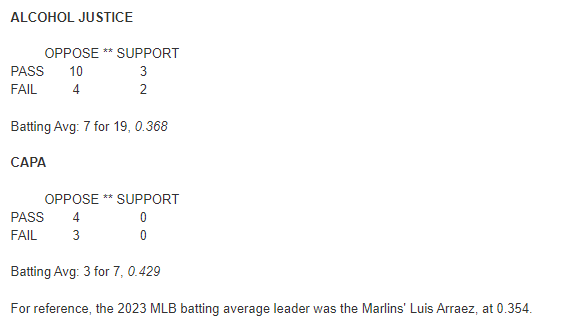
The 2023 California legislative session wrapped up at the end of October. It was a strange one, marked by Governor Gavin Newsom going on a veto spree, knocking off nearly 30% of the bills presented to him over a 3-day period. But as we feared from an executive whose private success has come through the alcohol industry, the red pen did not touch any of the concerning alcohol-related bills.Of the 29 bills tracked by Alcohol Justice this year, none were vetoed, and 18 (62%) were signed into law. All of California’s alcohol-related bills, including summaries and our analysis, are compiled on the California Legislative Tracker page.
The statistics for Alcohol Justice and the California Alcohol Policy Alliance (CAPA)’s key bills are below. (Bills that Alcohol Justice took a WATCH position on are excluded, while CAPA never takes WATCH positions.) The fate of legislation of particular interest is summarized below.

KEY BILLS
SB 76 aka the Party Zone Bill. Opposed by both AJ and CAPA, SB 76 was signed into law and therefore we count it as a defeat. But this belies the resounding success that public health and safety advocates had in mitigating the threats from this bill. As originally written, it allowed any jurisdiction in California to declare any arbitrarily sized area an “Entertainment Zone,” allowing bars to sell directly out the door. The originaly version of this bill contained no provisions for on-street age verification, no requirements for motor vehicle traffic mitigation, and no constraints on times of day or days of week. After AJ and others provided testimony highlighting these concerns, the bill was amended to require age verification within the zone, restrict the zones only to times during which a special events license had been issued, and finally authorize them only in the City of San Francisco. There remains the concern that this is just a “nose under the tent,” and other jurisdictions will demand it as well, as well as the more specific concern that San Francisco leadership has been erratic at best in terms of public health and safety concerns. But in the end, this was about as close to a legislative victory as a loss can be.
SB 495 aka the Alcohol On Demand Bill. This bill was also opposed by both AJ and CAPA, and failed in the Assembly GO committee. But in contrast to the Party Zone Bill, SB 495 was as close to a loss as a victory can be. The rapid rise of alcohol by delivery remains a deeply concerning development, and ongoing analyses from the Alcohol Research Group show that it shows the potential to push reckless drinkers over the edge. However, the fight over app-based delivery and cocktails to go obscures the fact that California made the reckless decision to allow these kinds of deliveries years ago–so long as it was sealed bottles. The big change made in the delivery bills that author Sen. Dodd has been pushing for the past four years comes frfom the delivery of drinks that were prepared by a restaurant or bar. The continued explosion of alcohol provision rights is worrisome in itself, and this kind of policy begs for the establishment of a “ghost bar” that does not serve anyone inside, only sends of pre-mixed cocktails with minimal staff. At the same time, the delivery industry itself is dominated by venture capital-backed megacorporations that use market penetration and vast cash reserves to avoid all accountability. SB 495 provided a framework by which these enormous, reckless tech concerns could be nominally reigned in, making them answerable to the California Department of Alcoholic Beverage Control (ABC), preventing them from making their contractors take the fall for illegal deliveries, and imposing penalties at a scale that would make them sit up and take notice. For a bad result (the inclusion of mixed drinks in delivery orders), this was probably the best way it could have been done.
AB 840 aka the Bud Ads for Undergrads Bill. Again, opposed by both AJ and CAPA, and again, a loss (this time unmitigated), AB 840 opened a large number of California State University facilities to alcohol advertisements. The actual mechanism of the bill–providing waivers to tied house restrictions that would prevent alcohol industry players from purchasing ad space in stadiums and theaters–has been in play for at least the past decade, carving exceptions for facilities one by one. The little-contested passge of these kinds of bills, despite periodic negative press, clearly embolden author Assm. Dawn Addis to deregulate multiple facilities across eight campuses in one fell swoop. But college campuses are home, often literally, to a large minority of underage students. That does not even figure in community use; in testimony, an executive from California Polytechnic San Luis Obispo bragged that the facility the ads would be displayed in hosted 12,000 kindergarten through 12th graders. The fact that this did not raise flags with Addis, who indentifies herself as an educator, is deeply disappointing. The fact that it raised no flags with anyone, however, calls to mind deeper systemic failures. When we do not do enough to flag small chips in the pillars of protective regulations, someone like Assm. Addis will come along and knock the whole edifice over.
AB 929 aka the Flight Attendant’s Nightmare Bill. Let’s not get too bogged down in grey areas and frustratingly cynical deregulation efforts. Some bills are unmitigated disasters, and CAPA and AJ can make a clean stop. AB 929 would have allowed drinks sold in airport bars to be carried around the terminal and consumed at leisure. As the post-COVID environment promotes intoxicated passengers making staff and fellow fliers miserable, the alcohol industry still pushes legislation like this to eke more money from stressed and depressed travelers. The bill met fierce opposition in the Assembly GO committee and died there, an early and resounding victory for prevention.
AB 1130 aka the Did You Even Read the Bills Bill. Supported by AJ but outside of CAPA’s (already overloaded) agenda, this bill formally removed “addict” from legislation, replacing with “person with a substance use disorder”. Because evolving DSM-V criteria have rendered “addict” descriptively useless, this change is both destigmatizing and more scientifically accurate. So needless to say, when the legislature wrote its controversial enhancement of involuntary commitment guidelines, it specified “severe substance use disorder” and… “alcoholism.”
As always, there were many more bad ideas, and a few good ones, not acknowledged here. For more information, please see our Legislative Positions page and do not hesitate to contact us with any questions or to get more involved.
For the next couple months, AJ, CAPA, our allies, and you can relax, celebrate our wins, and prepare for the coming year’s fights. The industry constantly champs at the bit to dismantle the edifice of protective legislation. We know, however, that the combined strength of concerned Californians can and will keep them at bay.
Image courtesy mark6mauno on Flickr. Used under Creative Commons license.
